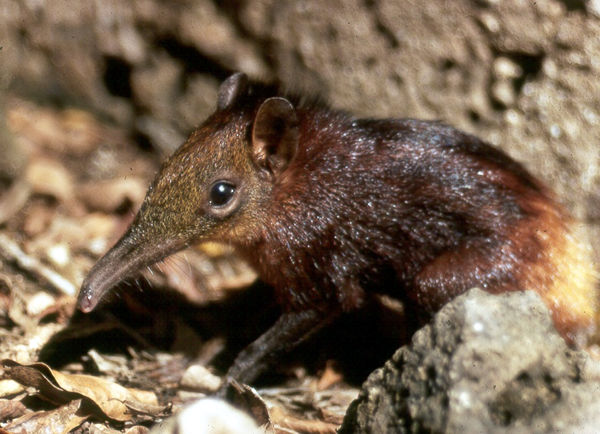 |
| Image by Galen Rathbun |
This is the Golden-Rumped Sengi (Rhynchocyon chrysopygus). “Sengi” is the new, fashionable term for elephant shrews, because elephant shrews are more closely related to elephants than shrews. All of the following (and proceeding) information I just found while looking up stuff on the Sengi2. Currently, taxonomists are having a field day with a wide variety of African mammals. It turns out that elephants, manatees, hyraxes, sengis, golden moles, tenrecs and the aardvark all are related to an ancient African mammal. Everything within is now grouped into the superorder Afrotheria, which, if I’m not too wrong with my Latin, means African Beast.
The Golden-Rumped Sengi is about nine inches long (bigger than I thought an elephant shrew was; that’s about the size of a full-grown Norway rat), with surprise, surprise, a yellowish orange patch on its rear. Under this patch is a thick dermal shield, which is used to protect against the biting attacks of other Sengis. They mate for life, living in monogamous pairs, and they jointly protect their territory. Males will chase off intruding males, and females will chase off intruding females.
The sengis use their long, flexible snout3 to seek and destroy insects and other yummy invertebrates that inhabit the leaf litter in the Kenyan forests in which they live. Being a small, and apparently tasty, mammal they’ve got to watch out for hawks and snakes. They escape by running up to 15 miles per hour, which is dang fast for something that small. After spotting such danger and sprinting away, they slap their tail on the ground as a warning. The predator then knows that it’s been spotted, so an ambush is out of the question.
Living, as they do in Kenya, habitat loss and fragmentation is the major issue facing the Golden-Rumped Sengi. In fact, their range is limited to two patches on the Kenyan coast; luckily (or more likely, because) those places are protected. Illegal hunting for food does happen, but ARKive says, “current levels are thought to be sustainable.” The California Academy of Sciences even says that it is possible to breed them in captivity.
1She really should get a blog, so I can link to her instead of her sister, who I’ve linked to enough that it’s easier just to put her on the sidebar.
2This blog is as much for my edification as anyone else’s. Heck, in just the last three weeks, I’ve learned to correctly pronounce “uakari,” what the thing on the top of a cassowary’s head is called, and of the existence of a blind wolf spider.
3You should really check out the ARKive videos on this. So creepy.

2 comments:
Yeah, we are working on getting Midge a blog :)
Did you see that the Journal Endangered Species Research is now free online?
http://www.int-res.com/journals/esr/
Nice, and nice. I'll be trolling that fairly constantly for new EUTs.
Post a Comment